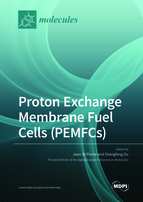Proton Exchange Membrane Fuel Cells (PEMFCs)
A special issue of Molecules (ISSN 1420-3049). This special issue belongs to the section "Electrochemistry".
Deadline for manuscript submissions: closed (31 January 2020) | Viewed by 44402
Special Issue Editors
Interests: electrochemical energy systems; proton exchange membrane fuel cells including water management, freezing, degradation mechanisms, mathematical modeling, diagnosis and measurement methods, electrocatalysis, pure oxygen operation and reactant stream unit operations (gas separation and fuel reforming catalysts); flow batteries; water electrolyzers
Interests: electrochemical engineering; polymer electrolyte fuel cells including electrode design and diagnosis, flow field plate coating, stack design; direct alcohol fuel cells; polymer electrolyte water electrolyzers; zinc-air batteries; nanoparticle characterization
Special Issue Information
Dear Colleagues,
A proton exchange membrane fuel cell (PEMFC) spontaneously produces power, heat and water from the oxygen in the air and a fuel. Hydrogen is preferred as the fuel because it is a renewable fuel if synthesized, for example, by water electrolysis using electricity from renewable energy. Furthermore, fuel cells coupled with hydrogen manufacturing improve resiliency by fulfilling the energy storage needs of electric grids constrained by intermittent renewable energy generation (solar, wind). More specifically, discharge (fuel cell) and recharge (water electrolysis) durations exceeding a few days for power plant ratings below a few megawatts are not accessible to other energy storage technologies. PEMFCs are commercially available for a few applications including cars, forklifts, and generators for homes and backup systems. Improvements in cost, performance and durability are needed to assist commercialization efforts because the technology is not yet mature.
This Special Issue focuses on all PEMFC scientific and technological aspects that decrease cost and increase performance and durability, including novel characterization methods, mathematical models, and accelerated stress tests to gain additional insight, as well as degradation mechanisms, innovative materials and original cell component, cell, stack, and system designs.
Dr. Jean St-Pierre
Dr. Shangfeng Du
Guest Editors
Manuscript Submission Information
Manuscripts should be submitted online at www.mdpi.com by registering and logging in to this website. Once you are registered, click here to go to the submission form. Manuscripts can be submitted until the deadline. All submissions that pass pre-check are peer-reviewed. Accepted papers will be published continuously in the journal (as soon as accepted) and will be listed together on the special issue website. Research articles, review articles as well as short communications are invited. For planned papers, a title and short abstract (about 100 words) can be sent to the Editorial Office for announcement on this website.
Submitted manuscripts should not have been published previously, nor be under consideration for publication elsewhere (except conference proceedings papers). All manuscripts are thoroughly refereed through a single-blind peer-review process. A guide for authors and other relevant information for submission of manuscripts is available on the Instructions for Authors page. Molecules is an international peer-reviewed open access semimonthly journal published by MDPI.
Please visit the Instructions for Authors page before submitting a manuscript. The Article Processing Charge (APC) for publication in this open access journal is 2700 CHF (Swiss Francs). Submitted papers should be well formatted and use good English. Authors may use MDPI's English editing service prior to publication or during author revisions.
Keywords
- Proton exchange membrane fuel cell
- Cost
- Performance
- Durability
- Characterization
- Model
- Accelerated stress test
- Mechanism
- Material
- Design








